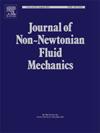Modelling viscoplastic interfacial flows inclusive of curvature effects
IF 2.8
2区 工程技术
Q2 MECHANICS
引用次数: 0
Abstract
This study presents a theoretical and numerical investigation of interfacial flows of oxidised liquid metals in a shallow annular channel in the absence of inertial effects. For the first time, viscoplastic surface behaviour induced by oxidation is modelled using a bi-viscosity law within a framework that also accounts for interfacial curvature governed by the Young–Laplace equation. By solving a coupled bulk-surface flow system, the effects of surface rheology, contact angle, and dimensionless capillary length on surface velocity and surface shear rate profiles are quantified. Results highlight the competing influences of hydrophobicity and viscoplasticity on surface and bulk flow characteristics and demonstrate that accurate modelling of such systems necessitates inclusion of both curvature and non-Newtonian surface effects. In appropriate limits, our numerical results are validated against semi-analytical solutions. Our findings offer insights relevant to metal casting applications.
包含曲率效应的粘塑性界面流动建模
本文对氧化液态金属在没有惯性效应的浅环形通道中的界面流动进行了理论和数值研究。第一次,由氧化引起的粘塑性表面行为在一个框架内使用双粘度定律进行建模,该框架也考虑了由Young-Laplace方程控制的界面曲率。通过求解一个体-面耦合流动系统,量化了表面流变性、接触角和无因次毛管长度对表面速度和表面剪切速率的影响。结果强调了疏水性和粘塑性对表面和体积流动特性的竞争影响,并表明此类系统的准确建模需要包括曲率和非牛顿表面效应。在适当的范围内,我们的数值结果对半解析解进行了验证。我们的发现提供了与金属铸造应用相关的见解。
本文章由计算机程序翻译,如有差异,请以英文原文为准。
求助全文
约1分钟内获得全文
求助全文
来源期刊
CiteScore
5.00
自引率
19.40%
发文量
109
审稿时长
61 days
期刊介绍:
The Journal of Non-Newtonian Fluid Mechanics publishes research on flowing soft matter systems. Submissions in all areas of flowing complex fluids are welcomed, including polymer melts and solutions, suspensions, colloids, surfactant solutions, biological fluids, gels, liquid crystals and granular materials. Flow problems relevant to microfluidics, lab-on-a-chip, nanofluidics, biological flows, geophysical flows, industrial processes and other applications are of interest.
Subjects considered suitable for the journal include the following (not necessarily in order of importance):
Theoretical, computational and experimental studies of naturally or technologically relevant flow problems where the non-Newtonian nature of the fluid is important in determining the character of the flow. We seek in particular studies that lend mechanistic insight into flow behavior in complex fluids or highlight flow phenomena unique to complex fluids. Examples include
Instabilities, unsteady and turbulent or chaotic flow characteristics in non-Newtonian fluids,
Multiphase flows involving complex fluids,
Problems involving transport phenomena such as heat and mass transfer and mixing, to the extent that the non-Newtonian flow behavior is central to the transport phenomena,
Novel flow situations that suggest the need for further theoretical study,
Practical situations of flow that are in need of systematic theoretical and experimental research. Such issues and developments commonly arise, for example, in the polymer processing, petroleum, pharmaceutical, biomedical and consumer product industries.

 求助内容:
求助内容: 应助结果提醒方式:
应助结果提醒方式:


